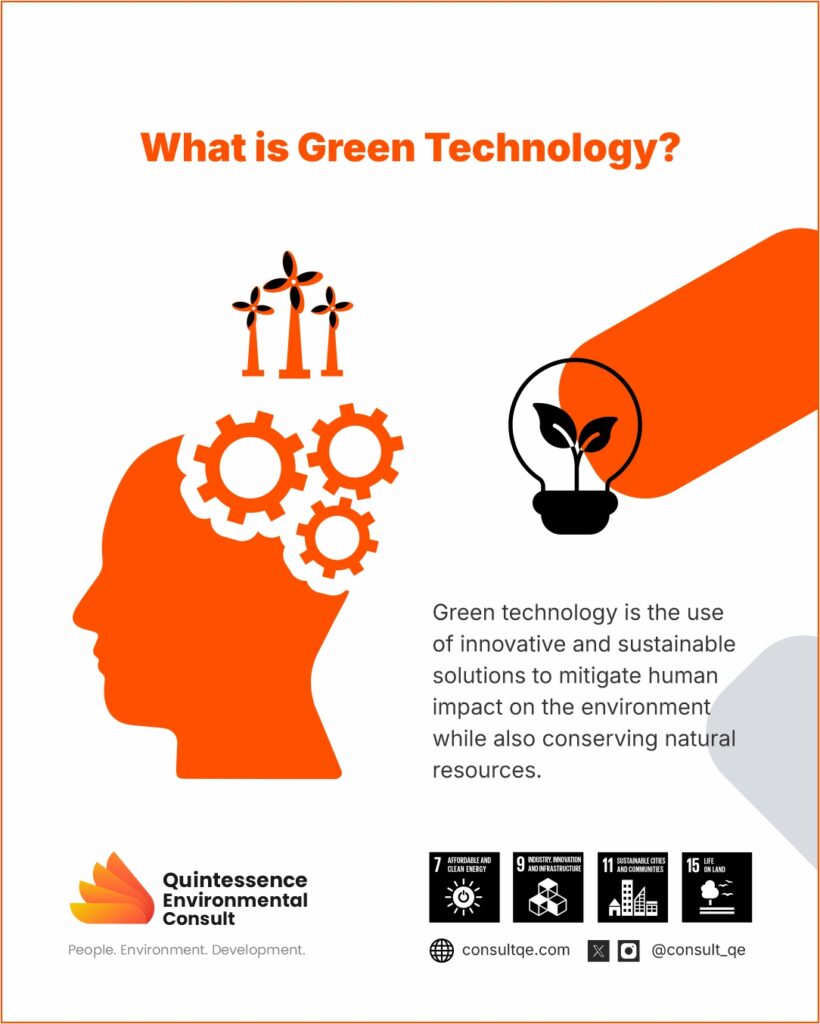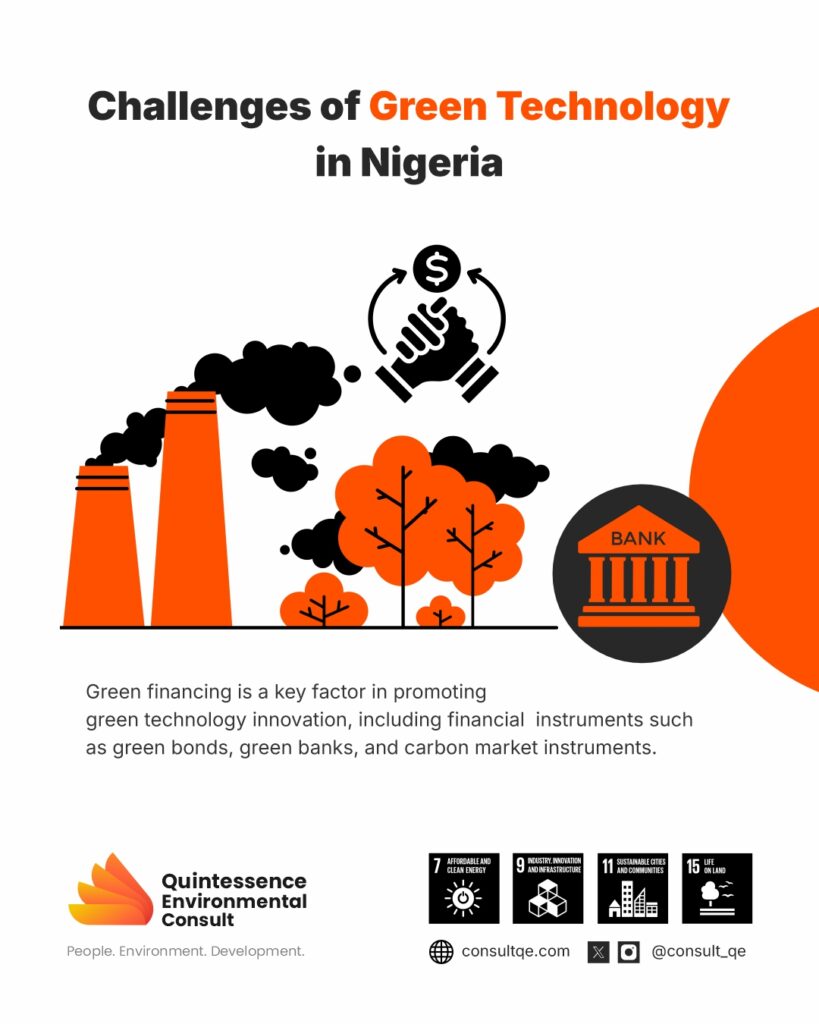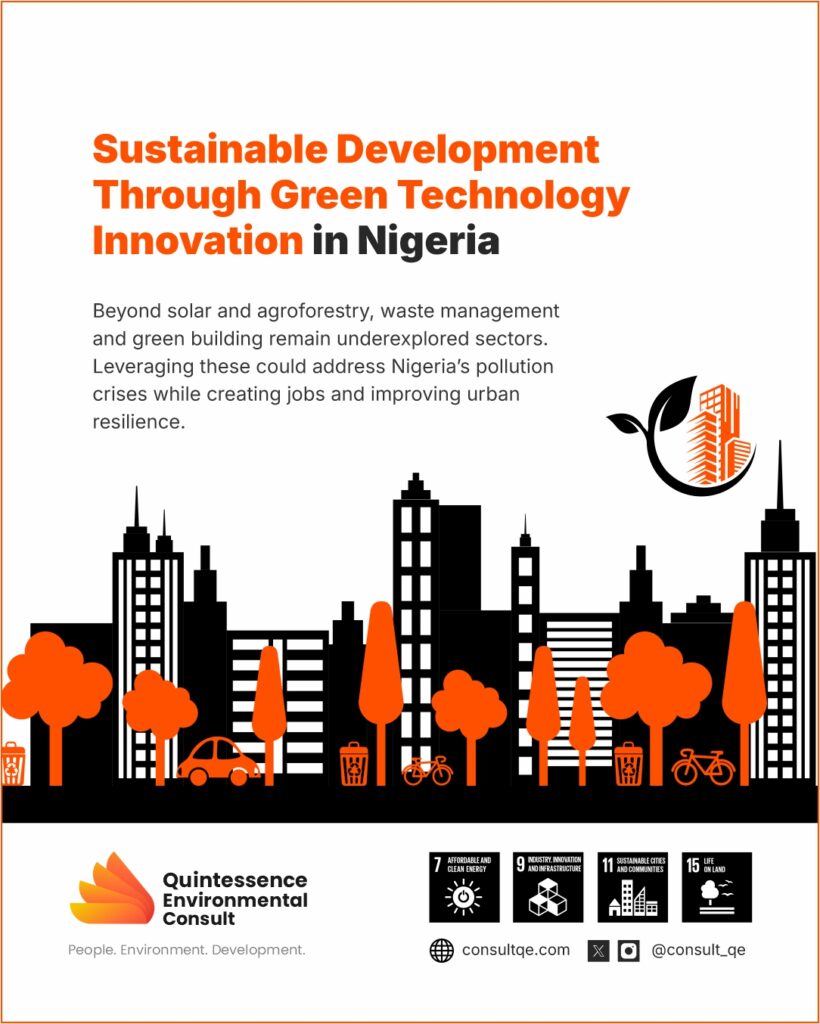KEY TAKEAWAYS:
- Green technology innovation is crucial for sustainable development in Nigeria, with potential impacts on the environment, social well-being, and economic growth.
- Some progress has been recorded in the renewable energy sector and agriculture through the work being done at the Rural Electrification Agency (REA), the National Agency for Science and Engineering Infrastructure (NASENI) and the Centre for Dryland Agriculture (CDA) to mention a few.
- Beyond solar and agroforestry, waste management and green building remain underexplored sectors. Leveraging these could address Nigeria’s pollution crises while creating jobs and improving urban resilience.
- Key barriers to implementing green technology in Nigeria include limited government policies fostering innovation, limited green financing, and a gap between the innovation space and the real sector.
- Green financing is a key factor in promoting green technology innovation, including financial instruments such as green bonds, green banks, and carbon market instruments.

INTRODUCTION
Population growth and expanding industrial activities have driven a significant rise in natural resource consumption and electricity demand. The extraction of these resources and the use of fossil fuels to generate electricity lead to environmental issues such as deforestation, biodiversity loss, pollution, resource depletion, and global warming. Hence, there is a need to plan, organize, and control human activities to manage our resources for our efficient use and the use of future generations.
Sustainable development encompasses social, environmental, and economic aspects. One of the many strategies that can achieve all aspects is the implementation of green technology. In Nigeria, The Energy Commission of Nigeria (ECN), is responsible for strategic planning and coordination of national policies in the energy sector. ECN has developed the Renewable Energy Masterplan (REMP) to promote an increase in the supply of renewable electricity from 13% of total electricity generation in 2015 to 23% in 2025 and 36% by 2030 [4]. Also, the Centre for Dryland Agriculture (CDA) is promoting sustainable agricultural practices through training, outreach programs, and research in areas such as molecular biology, plant tissue culture, geographic information system (GIS) & remote sensing, soil & plant analysis, and food analyses. [1]
WHAT IS GREEN TECHNOLOGY?
Green technology is the use of innovative and sustainable solutions to mitigate human impact on the environment while also conserving natural resources. It has gained global adoption across diverse sectors such as agriculture, renewable energy, waste management, water treatment, sustainable construction (green building), and pollution control.
Advantages of Green Technology on the Scope of Sustainable Development
Environmental Impact: Green technologies mitigate environmental issues, such as pollution, biodiversity loss, and resource depletion. Renewable energy, for example, displaces fossil fuel dependency, which minimizes hydrocarbon contamination of aquifer systems and particulate emissions. Circular economy practices, such as material recycling and upcycling, reduce waste generation and extend product lifecycles.
Social Impact: Green technologies provide social amenities, such as healthcare, education, and accessible clean water. Solar-powered water purification systems in remote areas provide portable water and eradicate waterborne diseases. Sustainable agro-techniques (e.g., integrated pest management, precision agriculture) minimize agrochemical runoff, preserving soil health and bolstering food security through resilient crop yields.
Economic Impact: Green technology drives cost-efficient innovation and labour market expansion. Waste recycling industries reduce raw material procurement costs while generating employment across the collection, sorting, and processing sectors. Renewable energy infrastructure development stimulates high-skilled job creation in engineering, manufacturing, and maintenance, fostering inclusive economic growth.
Green technology has the potential to make significant contributions to achieving sustainable development by addressing environmental issues, improving social well-being, and fostering economic growth. [9]
GLOBAL INITIATIVES OF GREEN TECHNOLOGY
Denmark implemented green technology through wind power renewable energy source. Thus, becoming the country with the highest share of wind power in the world by generating 47% of its electricity from wind power in 2019 [6] and with a target of reaching 60% by 2030 [5]. This has enabled the country’s greenhouse gas emissions (GHG) to be reduced to 41.7% in 2020 from its initial 71.1% in 1990. [3]
India, a developing country, has also implemented green technology as a tool for its Railways. Indian Railways is the national railroad carrier that transports more than 16 million passengers and 1.5 million tonnes of freight daily, with 1.34 million employees. It consumes almost 2% of India’s total electricity consumption. Employees of Indian Railways reside in housing colonies that utilize energy-inefficient incandescent lamps (ICLs) for their lighting needs, thus increasing peak electricity demand in the evening. Hence, a multidisciplinary project team was given the task of looking for solutions that would reduce peak electricity demand in housing colonies through the adoption of green technology by its employees. The biggest challenge for the project team was to figure out the financing mechanism, to kick-start the project. Various options that were put forth during brainstorming sessions include;
- subsidy by the government,
- initial free supply of the product but with monthly installment payback,
- subsidy reduction for electrical consumption (to make the green technology more attractive),
- subsidy for manufacturers (to reduce the cost of producing green technologyproducts)
But they were rejected by the government. The project team found a workable solution and successfully implemented it to provide green lighting solutions in approximately 400,000 households of Indian Railways. The Indian government launched schemes like the UJALA (Unnat Jyoti by Affordable LEDs) scheme to promote the replacement of ICLs with energy-efficient LED bulbs. This project resulted in a significant reduction of peak lighting load without compromising on the lumen output and, thus, contributed towards sustainable development. [10]
Some case studies of ongoing green technology projects include;
- Singapore’s Green Building Initiative – It is part of the Singapore Green Plan 2030, the nation’s collective effort to advance the agenda on sustainable development. It aims to deliver these three key targets of “80-80-80 in 2030”
- greening 80% of Singapore’s buildings,
- 80% of new developments to be super low energy,
- 80% improvement in energy efficiency. [13]
- In the case of Uganda, a developing country, joining the Sustainable Energy for All (SE4All) initiative with its goals being;
- More than 98% of the population has electricity access from mainly solar PV but also from hydropower., geothermal, wind power and biomass,
- More than 99% of the population has access to modern cooking solutions, through the use of highly efficient cook stoves, electric cooking, biogas and so on.
- Yearly improvement in energy intensity by 3.5% and
- Renewable share in final energy consumption for power to at least 90%.[12]

OPPORTUNITIES OF GREEN TECHNOLOGY IN NIGERIA
Nigeria, with its vast natural resources and growing economy, presents numerous opportunities for the adoption of more green technologies. Having already started with renewable energy systems such as solar energy and sustainable agriculture like agroforestry, other unexplored options include waste management and green building.
I. Green Building Solutions
Green Roofs Systems
The implementation of vegetative layers on rooftops integrates ecological and functional benefits. These systems reduce the urban heat island (UHI) effect through evapotranspiration and solar radiation management (SRM), enhance building energy efficiency via thermal insulation, improve atmospheric air quality through particulate matter filtration, and also contribute to urban biodiversity conservation.[9]
Building-Integrated Photovoltaics (BIPV)
BIPV system replaces conventional construction materials with solar cells, enabling dual functionality as both building envelopes and solar-renewable energy generators. It enables on-site electricity production, reduces reliance on grid-based fossil fuels, and augments building energy performance metrics, thus, advancing net-zero energy objectives in urban infrastructure. [1]
II. Waste Management Opportunities in Green Technology
Waste-to-Energy (WtE)
These technologies convert waste into usable energy, minimizing landfill dependency and pollution.
- Incineration: Burning waste at high temperatures with advanced filters to minimize emissions, generating steam to produce electricity.
- Gasification: Heating waste with limited oxygen to create synthetic gas, which can be used for heating or power.
- Pyrolysis: Disintegrating waste without oxygen to produce fuels like bio-oil and gas, offering a sustainable alternative to traditional disposal [12]
III. Composting Technologies
Converting organic waste into nutrient-rich compost involves:
- Windrow Composting: Piling organic waste in long rows and turning them periodically to aerate and speed up decomposition.
- In-Vessel Composting: This method uses enclosed containers or reactors to control the composting process, often with automated aeration and temperature control, suitable for large-scale composting.
- Static Pile Composting: Creating piles of organic waste that are left to decompose without turning, relying on natural aeration and moisture levels.[10]
CHALLENGES OF GREEN TECHNOLOGY IN NIGERIA
In recent times, Nigeria’s signatory to the Paris Agreement on climate change has caused an exponential increase in the government’s drive to reduce greenhouse gas emissions, end gas flaring by 2030, and reduce its dependency on fossil fuel for energy generation. Thus, igniting the integration of renewable energy. Similarly, the debilitating power supply challenge in the country has pushed citizens towards acquiring solar power systems to meet their energy demands. However, it can be insufficient during the wet season. Hence, there is a need to implement other green technologies that meet both rural and urban energy demands and mitigate environmental problems.
However, there are some factors limit the adoption of green technologies in Nigeria, such as:
- Insufficient Policy Frameworks and Regulatory Incentives
The absence of robust government policies and regulatory frameworks undermines the transition to green technologies. Effective fiscal mechanisms—such as subsidies, tax waivers, tax credits, and targeted grants—are critical to incentivizing private-sector investment and public adoption. For instance, subsidies can lower the upfront costs of renewable energy systems (e.g., solar panels), making them accessible to households and businesses. However, Nigeria’s current policy landscape lacks coherent strategies to prioritize green innovation, leaving industries and consumers reliant on fossil fuel-dependent infrastructure. Without legislative backing and long-term incentives, scaling green technologies remains economically unviable for developers and end-users [8][15]. - Limited Access to Green Financing Mechanisms
Transitioning to low-carbon technologies requires dedicated financial ecosystems, which Nigeria’s market currently lacks. Green finance tools—such as green bonds, carbon credit markets, climate-focused grants, and green investment banks—are essential to fund renewable energy projects, energy-efficient infrastructure, and sustainable waste management systems. However, limited awareness of these instruments, underdeveloped capital markets, and weak regulatory oversight hinder their adoption. Financial institutions often perceive green projects as high-risk due to uncertain returns, further restricting credit availability. Strengthening green financial infrastructure and fostering partnerships between banks, international donors, and local stakeholders are vital to unlocking capital for sustainable initiatives [7][15]. - Low Public Awareness and Behavioral Resistance
Widespread adoption of green technologies is affected by inadequate public awareness of their environmental and economic benefits. Many Nigerians remain reliant on fossil fuels and single-use plastics due to ingrained habits, limited exposure to alternatives, and misconceptions about the affordability of green solutions. For example, solar energy systems are often viewed as luxury investments rather than as cost-saving and long-term solutions. National campaigns led by agencies like the National Orientation Agency (NOA), in collaboration with NGOs and media platforms, are urgently needed to promote behavioural change. Public sensitization programs must emphasize the health, economic, and ecological risks of pollution while showcasing accessible green alternatives, such as biogas for cooking and/or recycled materials for construction [15].

CONCLUSION
Green technology is a compelling solution and approach for sustainable development in Nigeria. While progress has been made in renewable energy and sustainable agriculture, significant opportunities remain untapped in sectors such as waste management and green building. Leveraging these areas could address Nigeria’s pressing pollution crises, enhance urban resilience, and generate employment, thereby advancing the United Nations Sustainable Development Goals (SDGs) 7, 9, 11, 13, and 15. To achieve its sustainable development ambitions, Nigeria must adopt a multi-stakeholder approach to address the challenging factors involved in implementing green technology. With coordinated efforts, Nigeria can harness its vast natural and human resources to transition toward a circular economy, reduce greenhouse gas emissions, and secure a resilient, equitable future for generations to come.
REFERENCES
- About CDA. (n.d.). Centre for Dryland Agriculture. Retrieved March 20, 2025, from https://cda-buk.edu.ng/cda-pioneers-precision-agriculture-research-through-international-partnership/#:~:text=The%20DPA%20 technology%20provides%20a,of%20 the%20Centre’s%20core%20mandates.
- Amanina Azis, F., Rijal, M., Suhaimi, H., & Emeroylariffion Abas, P. (2022, September 23). Different Composting Technologies. Scholarly Community Encyclopedia. Retrieved March 19, 2025, from https://encyclopedia.pub/entry/27283
- Denmark’s climate targets and progress: Multilateral assessment in relation to Denmark’s fifth biennial report under the United Nations Framework Convention on Climate Change (SBI 60). (2024). Danish Ministry of Climate, Energy and Utilities. Retrieved March 11, 2025, from https://unfccc.int/sites/default/ files/resource/SBI60_MA_DNK-7June2024-Presentation.pdf
- Energy Policy and Planning. (n.d.). Energy Commission of Nigeria. Retrieved March 20, 2025, from https://energy.gov.ng/policy_ planning.php#:~:text=The%20 Renewable%20Energy%20Master%20Plan%20 (REMP)%20sets,with%20 active%20participation%20of% 20the%20private%20sector.
- https://www.google.com/amp/ s/www.construction21.org/amp/articles /h/denmark.html
- https://www.reuters.com/article/ business/environment/denmark-sources-record-47-of-power-from-wind-in-2019-idUSKBN1Z10KB/
- J.D. Sachs et al (n 66)
- J. O. Olujobi, M. O. Olujobi and E. U. Daniel, ‘The Legal Regime and Renewable energy as Alternative Sources of energy in Nigeria’s Power Sector: The Impacts and The potentials’ (2020) 19(3) Academy of Strategic Management Journal 1,19
- Kumar, J. K., & Shobana, D. (2024). Green Technologies and Sustainable Development: Opportunities and Challenges for Technology transfer. International Journal of Advances in Engineering Architecture Science and Technology, 2(5), 154–160.
- Kumar, S., & Hussain, M. (n.d.). Introducing Green Technology in Developing Nations: A Case of Indian Railways. Development of Learning Materials and Methodological Support on Sustainable Production and Consumption. https://prospernet.ias.unu.edu/wp-content/uploads/2012/09/SPC-learning-case-11_final.pdf
- Mihalakakou, G., Souliotis, M., Papadaki, M., Menounou, P., Dimopoulos, P., Kolokotsa, D., Paravantis, J. A., Tsangrassoulis, A., Panaras, G., Giannakopoulos, E., & Papaefthimiou, S. (2023). Green roofs as a nature-based solution for improving urban sustainability: progress and perspectives. Renewable and Sustainable Energy Reviews, 180.
- Richard, K., Nkwanga, D. K., & Olesen, G. B. (2023). UGANDA 100% RENEWABLE ENERGY SCENARIO AND PLAN BY 2050. In Inforse. Retrieved March 21, 2025, from https://www.inforse.org/africa/ pdfs/PUB_Plan_for_100_Renewable_ Energy_Scenario_Uganda.pdf
- Singapore Green Building Masterplan. (n.d.). Singapore Green Building Council. Retrieved March 20, 2025, from https://www.sgbc.sg/sgbmp/#:~: text=Singapore%20Green%20Plan%202030.,80&%2 D80%20in%202030%E2%80%9D. text=The%20earlier%20editions%20 of%20the,Singapore’s%20buildings %20have%20been%20greened
- Smith, A. R., Ghamari, M., Velusamy, S., & Sundaram, S. (2024). Thin-Film technologies for sustainable Building-Integrated photovoltaics. Energies, 17(6363).
- Tayo Douglas, Adebiyi Anthony Adepoju and Yewande Fadeke Oluwajobi (2024). Impacts of Green Technology on the Promotion of Renewable Energy in Nigeria: The Imperatives of Regulatory Mechanism. The Journal of Sustainable Development, Law and Policy. Vol. 15:3. 287-313. DOI:10.4314/jsdlp.v15i3.11
- Waste to Energy. (n.d.). Student Energy. Retrieved March 19, 2025, from https://studentenergy.org/conversion/waste-to-energy/#:~:text=Waste%20to%20Energy?-,Waste%20to%20Energy%20(WTE)%
2C%20is%20a%20term%20that%20is,
and%20converting%20it%20for
%20energy.



Inspiring! The focus on community-first initiatives and eco-friendly practices is exactly what our future needs. Excited to see how these strategies drive progress in sustainable mining and land restoration!